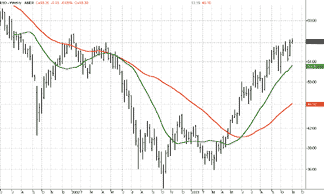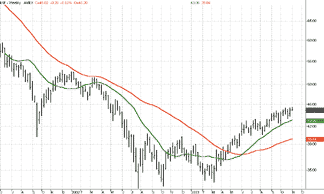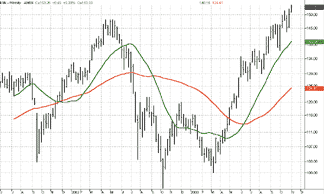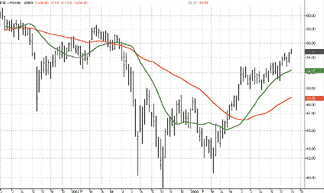INTERMARKET REVIEW
Russell 2000 Growth Index

The Russell 2000 Growth Index measures the performance of those companies in the Russell 2000 index that feature higher price-to-book ratios, as well as higher forecasted growth values. Major sector representation includes technology, healthcare, and consumer discretionary companies, with top holdings that include RF Micro Devices, Titan Corp., Sonus Networks, and Pacific Sunwear of California.
As measured by the Russell 2000 Growth Index iShare (IWO), small-cap growth stocks have been in a bull market since spring 2003 when they emerged from a bullish, "bottoming" pattern of three distinct lows. As the 20-week moving average crossed above the 50-week moving average in late spring/early summer 2003, small-cap growth stocks rallied strongly. After a short, sharp pullback in September, small-cap growth stocks resumed their bullish ways, heading for a test of the spring 2002 highs as November 2003 neared.
What they said: "Small-cap stocks once again significantly outperformed large caps in the second quarter. Will the corporate Davids continue to slay the market's Goliaths? Small-cap stocks' superior relative performance versus big caps throughout the three-year bear market significantly narrowed what was once an enormous valuation gap. However, based on valuations relative to earnings growth prospects, in our opinion, small-cap stocks are still more reasonably priced." -Mario Gabelli, portfolio manager and chief investment officer, The Gabelli Small Cap Growth Fund, "Shareholder Commentary," June 30, 2003.
Russell 1000 Growth Index

The Russell 1000 Growth Index measures the performance of those companies in the Russell 1000 index that feature higher price-to-book ratios, as well as higher forecasted growth values. Major sector representation includes technology, healthcare, consumer discretionary, and financial services companies, with top holdings including General Electric, Pfizer, Microsoft, Intel, and Wal-Mart.
As measured by the Russell 1000 Growth Index iShare (IWF), large-cap growth stocks never rose above their 20-week moving average during the post-September 11th rally in 2001. But the broad-based stock rally that began in spring 2003 lifted all stocks, including those of large-cap growth companies. Like their small-cap brethren, large-cap growth stocks featured a tripartite bottom from summer 2002 until spring 2003, though the breakout from this area was somewhat more sluggish than that in the small-cap growth sector.
What they said: "Patience with our investing style began to pay off in the third quarter, as investors began to focus again on company fundamentals such as earnings growth. In some ways, the [Standard & Poor's] 500 index's price action was nearly the opposite of the second quarter of 2003. Of the S&P 500 index's 50 worst-performing stocks for the quarter, eight had been among the 50 best-performing stocks just the quarter before." -H. Kent Mergler and Stephen Mergler, members of the portfolio management team, Northstar Capital Management, "Large Cap Growth Fund Manager Commentary," Fremont Funds at fremontfunds.com.
Russell 2000 Value Index

The Russell 2000 Value Index measures the performance of those companies in the Russell 2000 index that feature lower price-to-book ratios, as well as lower forecasted growth values. Major sector representation includes financial services, consumer discretionary, and materials and processing companies. Top holdings in the index include: Louisiana-Pacific Corp., BJ's Wholesale Club, Standard-Pacific Corp., and York International Corp.
As measured by the Russell 2000 Value Index iShare (IWN), small-cap value stocks were among the stars of the post-September 11th rally in 2001, breaking out above both its 20- and 50-week moving averages by November of that year. Small-cap value stocks fell back into a bear market in spring 2002 and remained depressed until spring 2003, when they rocketed in the broad-based stock market rally that accompanied the initial hostilities of the invasion of Iraq. Small-cap value stocks have been the strongest group (compared to large-cap value and growth stocks, as well as small-cap growth) coming off the March 2003 lows and, as of November 2003, had taken out the spring 2002 highs.
What they said: "Historically, reductions in capital-gains taxes have unleashed a fury of entrepreneurial activity, with new businesses and even industries created. Reducing capital-gains tax rates also has been shown to spur mergers and acquisitions activity. Our underlying investment methodology for the fund is to determine a company's private market value ... and then buy the stock at a deep discount to that value." -Richard Weiss & Ann Miletti, Strong Advisor Common Stock Fund, "Investment Reviews," estrong.com.
Russell 1000 Value Index

The Russell 1000 Value Index measures the performance of those companies in the Russell 1000 index that feature lower price-to-book ratios, as well as lower forecasted growth values. Major sector representation includes financial services, utilities, consumer discretionary, and integrated oils. Top holdings in the index include Citigroup, Exxon Mobil Corp., Bank of America Corp., and Verizon Communications.
As measured by the Russell 1000 Value Index iShare (IWD), large-cap value stocks have outperformed their large-cap growth peers - even if they have not performed as well as small-cap value stocks - since the spring 2003 lows. Large-cap value stocks briefly broke out above their 20-week moving averages in the rally coming off the September 11, 2001, lows, but by spring 2002 these stocks were once again well within a bear market. Large-cap value stocks late in October and November 2003 broke out of a brief, summer-long consolidation, and now looked poised to test the highs of the earliest months of 2002.
What they said: "So far, the rebound in stocks has been textbook. Small-cap stocks have led the market in the first year after each of the last nine recessions, and this time has been no different. Large company stocks also rallied strongly but the move is much less intense. As the rebound matures, there is a shift from low-price, low-quality stocks, to higher-quality names. Such a shift in market leadership is likely to occur within the next six months." -Jeffrey Shaw, manager, Harbor Large Cap Value Fund, "3rd Quarter 2003 Commentary," Harbor Fund at harborfund.com.
Originally published in the February 2004 issue of Technical Analysis of STOCKS & COMMODITIES magazine. All rights reserved. © Copyright 2004, Technical Analysis, Inc.
Return to February 2004 Contents